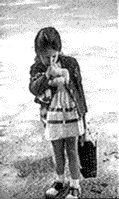
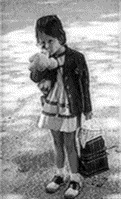
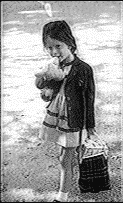
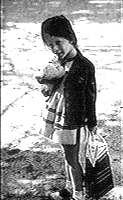
CAMERAS DON'T TAKE PICTURES
PAUL BYERS
Still photography is probably the least studied and least understood of today's communication media. Such understand as we have is, I believe, largely borrowed from other media and inappropriate to still photography. Although I am concerned with photography as a medium, that is, as a cultural invention, I am more concerned with its use as a research tool in the study of human behavior.
Our present American society regards communication much as it regards love or virtue: there, should be more of it and it should get better and better. Each medium is seen to be engaged in a common upward enterprise: that of fabricating increasingly higher-Fi equipment and creating higher-Fi messages to send over it. A medium may be described in terms of "who sends what messages to whom over what channels and with what consequences"--a paradigm suggested by Harold Lasswell. This formulation may serve passably for comparative description of media, but the sender-receiver model of the communication process is not suited to increasing an understanding of the potential uses of still photography in behavioral science.
Still photography is usually considered either as art or as technology. It is art when it is art and that does not concern me here. And since writers do not suppose that their pencils and typewriters write, I prefer to think that cameras and the rest of the photographer's technological paraphernalia do not take pictures. I prefer to see photographs as objects with which people arrange and rearrange relations among themselves, and photography as a social interaction; as Marshall McLuhan said in Understanding Media, "Nobody can commit photography alone."
Some people, especially photographers and photography editors, believe that there is a "real" meaning in and retrievable from photographs and that getting this meaning into and out of photographs is the main problem of communication in this medium. If one wants to find the origin of the "meaning" packaged in photographs, then presumably each of the three people involved in photography--photographer, subject, and viewer--should be examined.
The photographer may believe that he creates photographs (that is, originates messages) by some combination of perception and instrumentation. He usually however, tries to have his cake and eat it. He takes the credit for the message in his photographs while avoiding responsibility if the message isn't clear, by recalling that cameras "do not lie" and that subjects are often intractable. It is difficult to assign the origin of messages or meaning to photographers.
The subject--anyone who sits for or is otherwise in a photograph-might suppose that he is the originator of the message, which emerges from his express ions, actions, and the like. But every subject soon realizes that his intention is always changed, ignored, or even subverted when he sees the photograph. This often suggests, to the subject, that the photographer is incompetent.
The viewer, when he reports what he sees in photographs and what they mean to him, may agree with neither the subject nor the photographer. It is quite possible for a girl in a photograph to look sexy to the subject herself, petulant to the photographer, and bored to a viewer.
When almost any photograph is shown to a group, people "see" different things in it. Although people talk to one another about photographs and often behave as though they agree about a photograph, a little probing will show that the agreement is usually about design, composition, or the identification of a few objects. One talks in captions, describing the obvious, and avoiding what a semanticist would call meaning.
The sender-receiver model, then, seems to imply that still photography is hopelessly unmanageable and unsemantic as a medium of communication. Yet photography becomes steadily more important and photographs more numerous in our civilization. Since the very elusive ness of "meaning" in a photograph and the diversity of overt responses to it are special characteristics of the medium, we might more usefully study the behaviors of the people who are involved in photography--the photographer, the subject, and the viewer.
The photographs above illustrate certain reactions that exist among these three people and show how photographic observations and various kinds of contextual data can be used to study the shared patterns in a culture.
The subject is a four-year-old girl. I am concerned for the moment only with the photograph on the right-the last of this sequence taken at intervals of several seconds. The girl's head is tilted slightly downward and facing about 45 away from the object of her gaze. (Thus she is looking somewhat sideways and up, forward.) Her eyes are slightly more closed or squinted than normal ("normal" is her usual position, established by seeing other photographs and expressions); her lips are slightly pulled back; her mouth is open only enough for the lower lip to rest against her thumbnail, which is against her upper teeth. (Her mouth is not closed around the thumb as in the other photographs.) Her right hand is not in a tight fist and thus it exhibits only enough tension to hold the stuffed toy. Her body, in contrast to the preceding photographs, is in a slight "S" curve following a line through head, shoulders, abdomen, left knee, lower left leg. Each of these elements, as we will see, is a significant part of a total pattern.




The photographer is a man (myself) who is "Interacting with the girl by looking at her, pointing a camera at her, and taking these photographs of her. (A relatively long focal-length was used so that I was somewhat farther, 20-25 feet, from the girl than the photographs suggest. These photographs were taken, incidentally, as part of a project in search of ways of recognizing developmental stages in young children more accurately than by simple reference to chronological age and more quickly than by testing.)
The viewer, for our purposes, is simply any member of the subject's and the photographer's culture someone who will recognize that this is a familiar female-to-male expression, sometimes called "coy" or, with children, "cute." This expression is culturally patterned; it is learned and performed by most females, beginning at the age of four, and the recognition of it (like the knowledge of words in the language) is shared by most members of our culture. This particular expression is a special pattern of the observable elements noted and part of the repertoire of American female behavior. Indeed, it appears repeatedly throughout American culture. In the photograph on the following page it is deliberately posed and reproduced for an advertisement in the expectation that it will be recognized by American viewers.
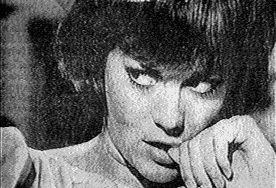
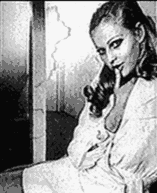
Now all this information forms a single whole. Given these photographs (even only the last one) and only one other of the three photographer-subject-viewer variables we could reconstruct the third and derive the relations among them. When we find a girl able to perform this expression we can infer that she is at least four years old. If we see the expression and know its place in the culture we can infer that the photographer is a man (with the proviso that in young children it may be practiced in varying form on all adults, since Americans call it "cute"). And when we see the expression deliberately performed (evolving from a quite different expression) and can find it elsewhere regularly in the society we can infer that it is a part of culture.
When behavioral scientists realized that the elements or units of an expression had the same relation to that expression that sounds have to words, it became possible to analyze the structure of behavior beginning with small bits of body motion. The units of eye position, body stance, limb position and -so forth combine in an exact way to form what is called an "expression" or gesture. These gestures, in turn are the communication elements of social behavior; the patterns of social behaviors are part of what the anthropologist calls culture. Ray L. Birdwhistell in his work in kinesics established the observational and analytic procedures for describing body motion systematically as communication behavior and observed that these "expressions" belong to the culture. They are not inventions of the individual actors.
People almost never discuss the personal significance in photographs. A mother looking at a photograph of her child may exhibit joy or disdain but her words are likely to be "It's a wonderful picture" or "The expression isn't right." Such behavior suggests that photography has found its present importance because each person looking at a photograph is permitted his private involvement with it and is not required to say what it "means" to him. In face-to-face communication with another person, we have only a limited amount of control over the messages that are presented to us. A speaker prepares his semantic package, directs its meaning at us, watches our reaction, and waits for a reply. He can see for himself whether or not we "get the message." Perhaps this continuous corrective feedback is not only communication but socialization itself--the way people establish and change their relations to each other. But our concern with communication is not really to get as much as possible (although it may be to give as much as possible) ; we wish to regulate screen, and otherwise control what we are required to deal with. And this is precisely what still photographs allow us to do. The most important characteristic of still photography is its susceptibility to individual control; each person involved with the still photograph has his own hand on his own semantic tuning-knob. In other media the message-sender gives the receiver as little opportunity as possible to reshape the message to the receiver's own comfort or interest. The sender tries not only to pre-package his message but to control his audience's involvement with it.
We can now build a new model for photography in which the photograph contains information but no meaning. The photograph is the product of the photographer-subject interaction and photography itself is a social transaction among photographer, subject, and viewer. Information then becomes simply a set of relations that can be observed without interpretation. Meaning is the product of this information and the involvement of a particular viewer, has relevance only in the form of the observed behavior of the viewer, and rests on no assumption about his feelings or emotional states. In this view, the photograph is not a "message" in the usual sense. It is, instead, the raw material , for an infinite number of messages which each viewer can construct for himself. Edward T. Hall has suggested that the photograph conveys little new information but, instead, triggers meaning that is already in the viewer.
This model implies that when a mother looks at a photograph of her child and does or does not like it, she is comparing the photograph with her own image of the child. If the photograph matches her image with satisfactory congruence, the picture is good. If it does not, the photograph is unsuitable. It also implies that the photographer does not "take the picture." His finger is on the shutter button and his energy will be used to push it, but the push itself is triggered at some particular point in his interaction with the subject. Even if his subject is a landscape, he interacts with it.
When certain of the arrangements among photographer, subject, viewer and photograph are understood and specified, photography can be used to investigate the behavior of any of the three persons involved. We can give cameras to our subjects-of-study, we can take photographs of our subjects-of-study, or we can observe our subjects-of-study involved with photographs. And since we are interested in the relations along the three entities, we never need to make a priori assumptions about the photograph itself.
Human behavior is patterns of patterns of patterns, decreasing in scope beyond normal social seeing. Seeing is learned and culturally influenced; we learn what to see and what not to see. In the still photograph, we can find relations frozen that are, in life, too fleeting for our eyes. If the telescope and the microscope provided new kind's of visual information (which we had to learn to see and analyze) based on new orders of magnification, the still camera provides a new order of seeing based on a change in time.
But since the information in a photograph is derived partly from the subject and partly from the photographer, the behavioral scientist has been faced with a dilemma: how to get photographic records that are sensitive to the rhythms and changes in human subjects and yet free from the contamination of the photographer's selectivity and influence. Some photographers have attempted to solve this problem by learning to "disappear," interacting so little with the subjects that they presumably do not alter the subjects' behavior. This may produce good, unposed photographs but not "uncontaminated" ones, for the very act of observing influences and selects what is observed. Others have attempted to avoid the problem by hiding the camera. Quite apart from ethical objections, hiding cameras rarely solves the contamination problem because there is usually someone who is privy to the hidden camera and who, because of his special knowledge, behaves in some small way that others cannot account for. Then this behavior contaminates the situation.
But the photographer is always a part of the context of the events he is photographing; he can never photograph human behavior without being a part of it, and his photographs are necessarily a product of his interaction and his selectivity. Americans, for example, tend to take pictures of people with "American" expressions. A few years ago one of my students taught a thirteen-year-old Puerto Rican boy in Spanish Harlem to use a camera and we now have a rich record of the human environment of this boy as he saw it--a record in the form of hundreds of photographs he took and hours of tape-recorded conversation with him about the photographs. In a similar fashion, an African might provide the anthropologist with a more precisely structured and accessible interpretation of his culture through the photographs he could take of it than through the words he may speak about it or, perhaps, even through the inferences the observer may make from his behavior. All this suggests not only that refined analytic techniques can be applied to still photographs, but that photography can become more than a recording or illustrating tool for behavioral science. It can become observation itself.